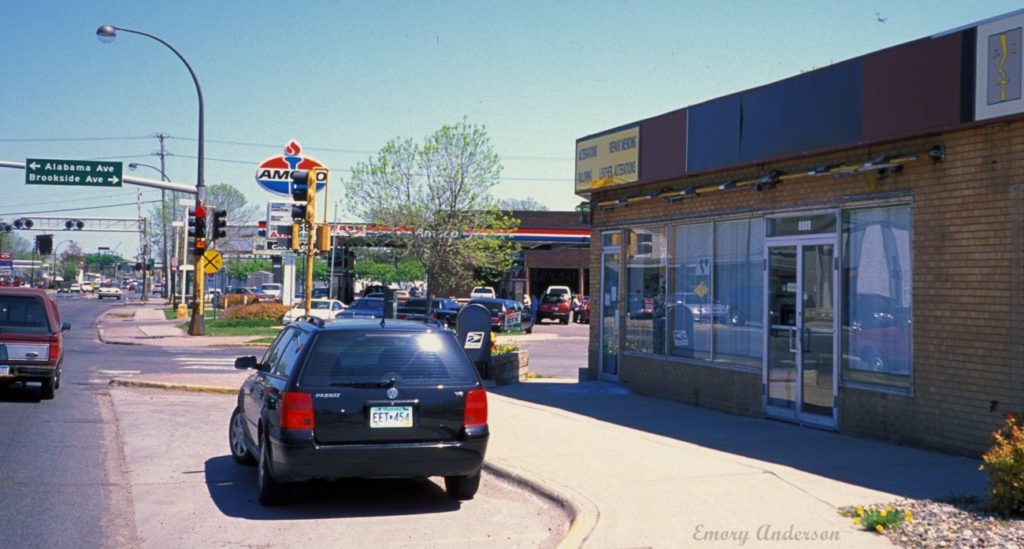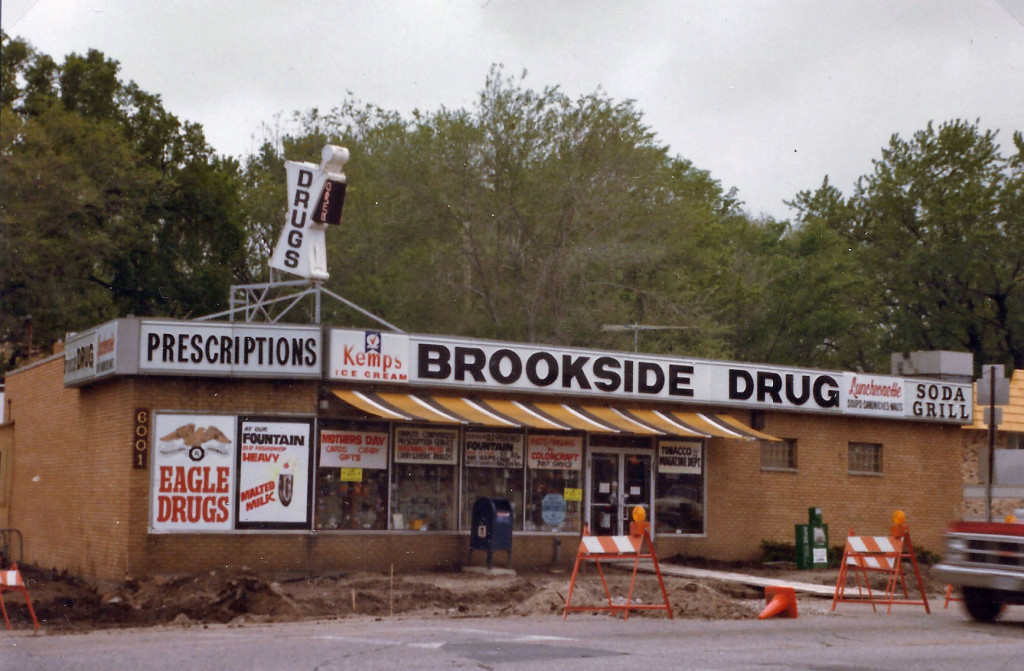Brookside Drug, located at the corner of Excelsior Blvd. and Brookside Ave., was a mainstay of the Brookside neighborhood for almost 50 years.
The building that would become most memorable as Brookside Drug was built in 1915, possibly by Henry Woerner, who built several shacks about 3-4 blocks south of Excelsior and had property (and possibly a gas station) on Brookside Ave. The building was originally stucco and had about 1,000 sq. ft. (For an idea of how it may have looked, see the abandoned antique shop at 4348 Brookside Ave.) The 6001 Excelsior Blvd. building went through many uses and owners:
In 1923 A. McGuire requested a permit to operate a store at Excelsior and Brookside; no indication of which corner.
In 1926 Harry J. Luscher applied for a permit to operate the Hollywood Inn. It was during prohibition, of course, so the establishment was a restaurant and soft drink parlor. Brookside resident Mell Hobard testified that public opinion was against the granting of a permit for the operation of that type of business. Despite the protests, the permit was granted on May 4, Although there is some indication that the Hollywood Inn was at the El Patio site, it is described as Excelsior and Brookside, and there was already a gas station on the other corner. (Across Excelsior Blvd. Brookside became Jackson/Alabama Ave.)
On May 18, 1927, the Brookside Brotherhood of the Brookside M.E. Church protested the granting of a license for dancing, presumably in vain.
In 1928 Mr. Arthur M. Bredeson received his annual permit to run his cafe in March. In June he petitioned to allow dancing.
[In September 1928, an article in the Hennepin County Review said that Hogan’s Barbershop was opening next to “the new bakery,” which may have been Hagen’s Bakery. The barbershop was at 4012 Brookside, so was the bakery the 6001 Excelsior site?]
In March 1929 Mr. C.H. Kavalaris wanted to open a restaurant at the site of the Hollywood Inn. (An entry for the Hollywood Inn on a building permit for the El Patio address across the street dated 3/28/1929 indicates that the establishment known as the Hollywood Inn was a barbeque place, and the owner was listed as Ed Nolan.)
In 1931 L.M. Duff requested a permit to operate a restaurant. So did Elliott Anderson, who wanted to serve lunches, pop, and milk.
COZY CORNER
In March 1933 a Mr. William F. Zahn requested a license for a restaurant and beer parlor, making the Cozy Corner one of many, many beer parlors that were unleashed at the end of Prohibition.
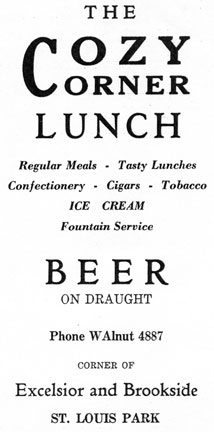
BROOKSIDE INN
In March 1934, henchmen for Baby Face Nelson mowed down local resident Theodore Kidder with machine guns at the corner of Excelsior and Brookside. Bullet holes were embedded in the stucco and were evident for many years. We know from the murder coverage that the place was called the Brookside Inn restaurant/cafe and confectionery, C. Wesley Smith, proprietor. Mr. Smith had obtained a license to expand for music and dancing.
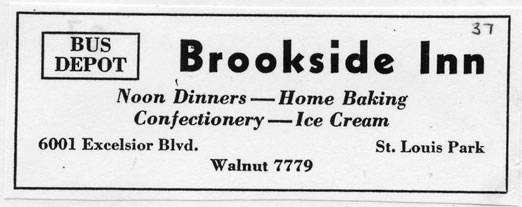
VENETIAN POOL
In the 1934 Directory the building was also advertised as the Venetian Pool, “The Beauty Spot of Excelsior Blvd.” Advertising language (“Marvelously Prepared Food, Refreshing Drinks”) was the same for both, leading us to believe that the inside was the Brookside Inn and the famous outside beer garden in the back (along Brookside Ave.) was the Venetian Pool. Beer had just become legal again, and this popular Beer Garden had tables with umbrellas in back when the weather was nice, and colorful lights strung for the ceiling. This setup particularly scandalized the neighborhood, since now Little Johnny could actually SEE people drinking beer, instead of just imagining what they were doing inside El Patio across the street.
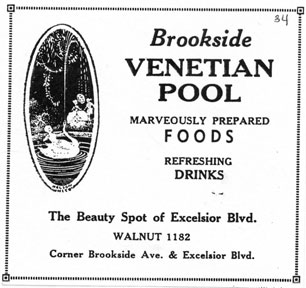
The new liquor ordinance prohibited minors to be in beerhalls, but parents protested that their children could no longer work there, so each parent had to individually request permission for his child to work. On May 2, 1934, Mr. P.K. Anderson received permission from the Village Council for his daughter Evelyn to work at the restaurant.
VENETIAN GARDENS
The ad below from the Hennepin County Review is date June 20, 1935. The place may have changed owners soon after; on November 25, 1935, Olav Vik and George Hanson applied for a beer license for their restaurant but were (at least initially) denied. Vik received approval on Feb. 3 of 1936.
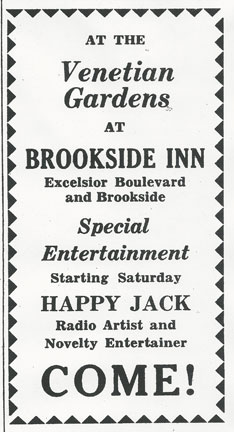
TIM’S PHARMACY
The building transitioned from the Brookside Inn to Tim’s Pharmacy No. 2 in 1937. Tim (H.F. Timmons)’s first pharmacy was at 4801 Minnetonka Blvd. Phyllis Poucher was the on-site pharmacist at the Excelsior Blvd. location (at the time all pharmacies had to be certified pharmacists.
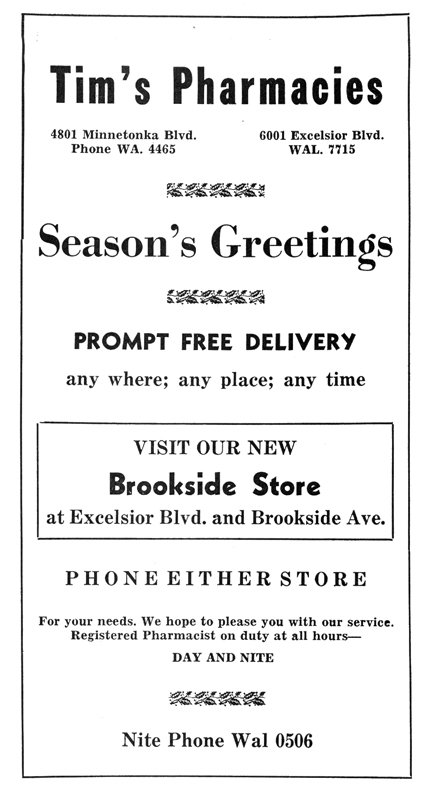
BROOKSIDE DRUG
In 1939 it finally took the name Brookside Drugs for the first time, Louis Biesecker, Proprietor. In December 1940 it was advertised as under new management. From 1942-46 it was run by Ralph J. Hunsaker, featured a complete modern soda fountain, and advertised “Downtown Prices Every Day.”
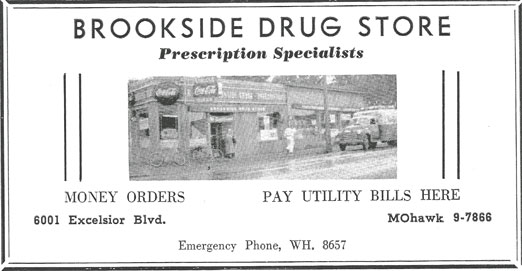
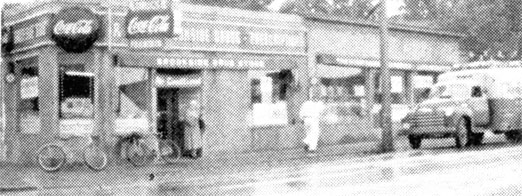
The building was purchased on or about September 29, 1946 by Leonard W. Hermann and run by Nate Goldstone, the store’s most memorable proprietor. Goldstone had been associated with the Alden Drug Co. for the past 12 years. In 1950 there was a fire at the Brookside Market grocery store next door, which prompted Hermann to purchase that property and reconstruct the two stores into one. The dividing wall was knocked out and the soda fountain was moved to the west wall. Since the two buildings were different heights, there was a decided slant in the floor as you walked from one part of the store to the other. The whole thing was stuccoed over. The Grand Opening of the “enlarged, modern” store was held on September 19-20, 1952. Goldstone also celebrated his sixth anniversary with the store.
In time the county made plans to widen, realign, and pave Excelsior Blvd. (and possibly also Brookside Avenue). This necessitated work to the buildings, which were both originally rectangular. Since some changes would have to be made to the drug store as a result, the landlord decided to reconstruct it, using the area in back of the building as well. The City also required changes, with a 20 ft. setback from Excelsior Blvd. and 10 ft. from Brookside Ave.
Reconstruction work was started with an architect’s plat of the “proposed building” (in its current shape) recorded in 1955. The building permit for the “construction of new Brookside Drug” was granted on June 4, 1956. In July a $23,000 addition was built to the back of the old building. Merchandise was moved to the new section through a hole in the southeast corner of the building, and only one business day was lost in the process. The old building was demolished, and the front of the building was rebuilt with block with a brick veneer. The new building sported 3200 square feet, double the size of the old, cobbled-together building. A Grand Opening was held on November 9-10, 1956 and the store was advertised as New, Bigger, Better.
The store enjoyed good times during the 1950s and ‘60s, serving coffee to businessmen in the morning, sandwiches to working girls at lunch, and chocolate sodas to kids after school.
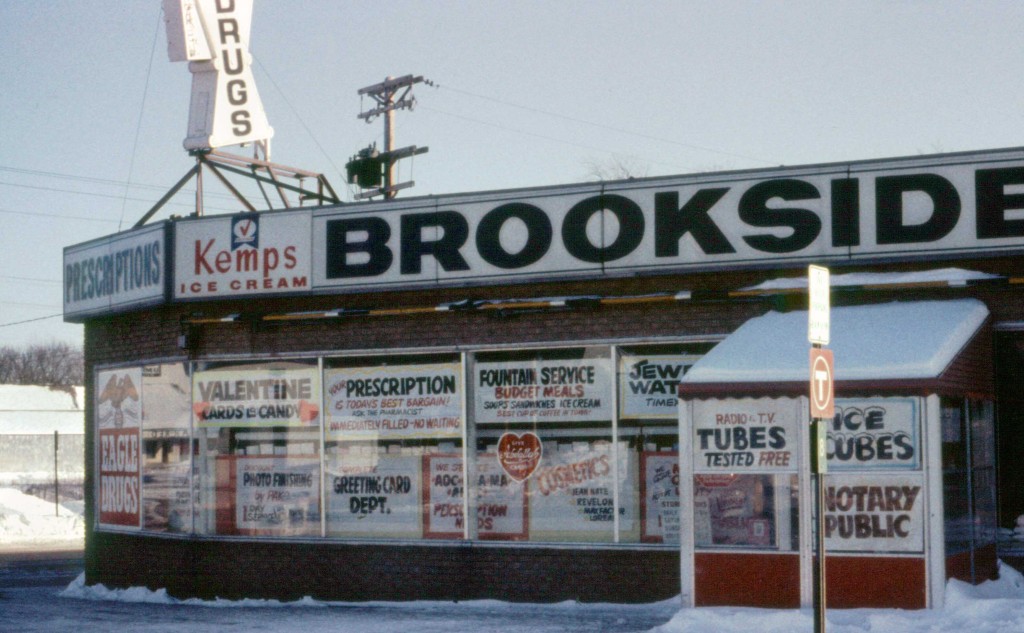
But eventually times changed, as drug chains emerged and grocery stores offered a wider variety of merchandise, including in-store pharmacies. Goldstone, who had acquired the property when Hermann died, liquidated his assets and Brookside Drug went out of business in 1988. The following year, new owner Ted Kvasnick subdivided the property into three separate storefronts and Sew What! opened in one of them in April 1989. Sew What! moved across Excelsior Blvd. in 2011.
